Member’s Remedies
VerifiedAdded on 2022/11/26
|7
|1892
|392
AI Summary
This document discusses the remedies available to minority shareholders in cases where majority shareholders use their powers unfairly. It explores equitable limitations and statutory protections under commercial and corporations law.
Contribute Materials
Your contribution can guide someone’s learning journey. Share your
documents today.
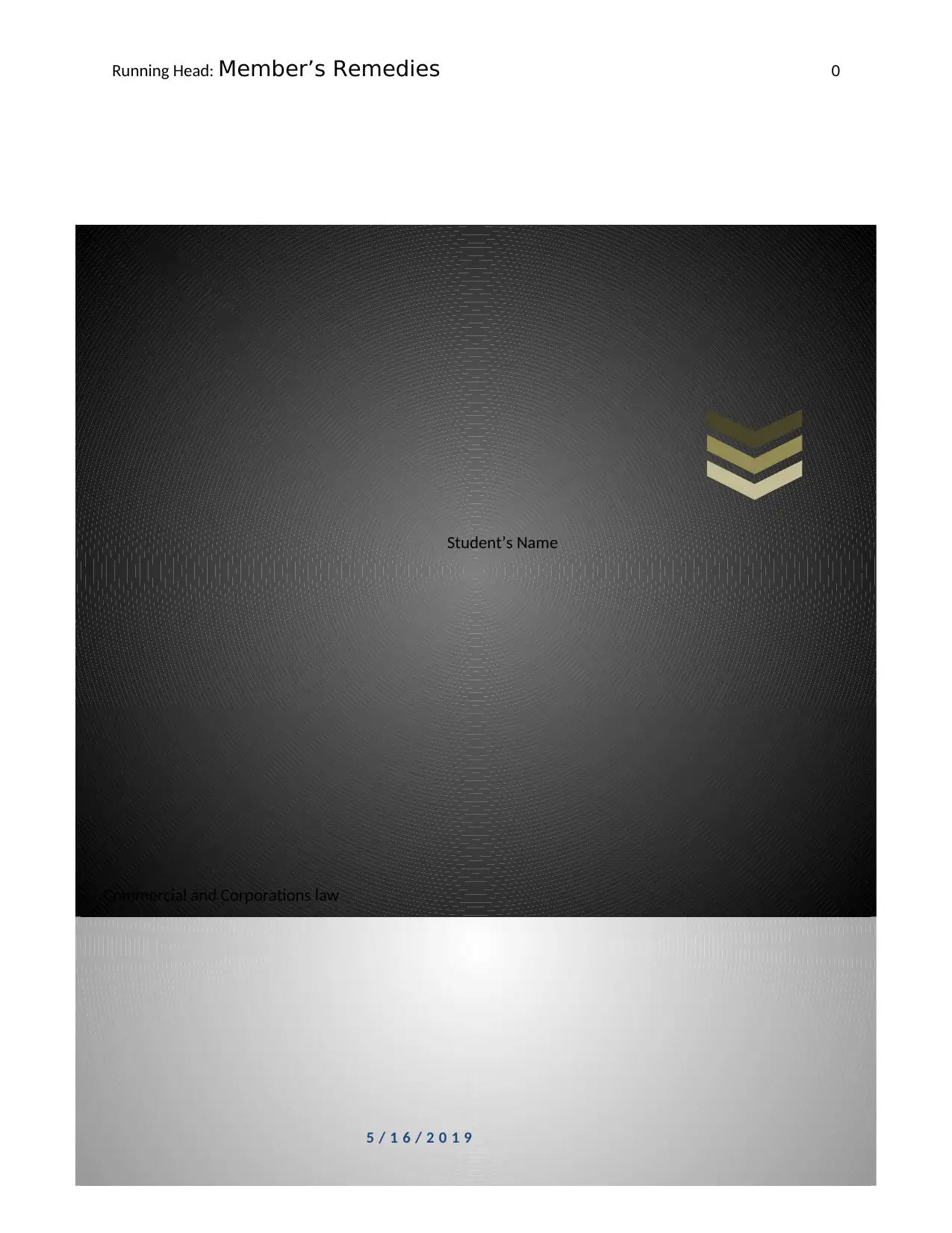
Commercial and Corporations law
Running Head: Member’s Remedies 0
5 / 1 6 / 2 0 1 9
Student’s Name
Running Head: Member’s Remedies 0
5 / 1 6 / 2 0 1 9
Student’s Name
Secure Best Marks with AI Grader
Need help grading? Try our AI Grader for instant feedback on your assignments.
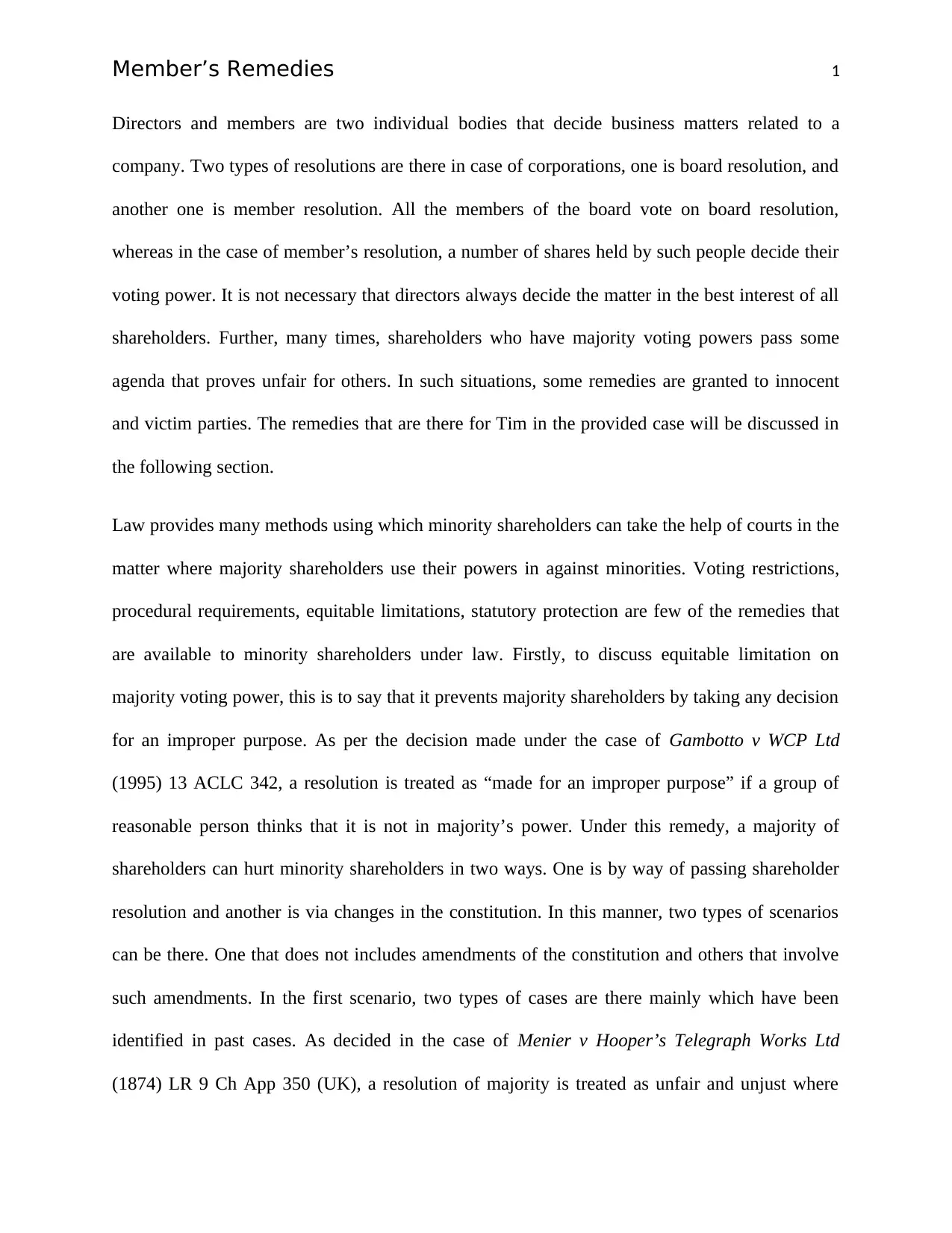
Member’s Remedies 1
Directors and members are two individual bodies that decide business matters related to a
company. Two types of resolutions are there in case of corporations, one is board resolution, and
another one is member resolution. All the members of the board vote on board resolution,
whereas in the case of member’s resolution, a number of shares held by such people decide their
voting power. It is not necessary that directors always decide the matter in the best interest of all
shareholders. Further, many times, shareholders who have majority voting powers pass some
agenda that proves unfair for others. In such situations, some remedies are granted to innocent
and victim parties. The remedies that are there for Tim in the provided case will be discussed in
the following section.
Law provides many methods using which minority shareholders can take the help of courts in the
matter where majority shareholders use their powers in against minorities. Voting restrictions,
procedural requirements, equitable limitations, statutory protection are few of the remedies that
are available to minority shareholders under law. Firstly, to discuss equitable limitation on
majority voting power, this is to say that it prevents majority shareholders by taking any decision
for an improper purpose. As per the decision made under the case of Gambotto v WCP Ltd
(1995) 13 ACLC 342, a resolution is treated as “made for an improper purpose” if a group of
reasonable person thinks that it is not in majority’s power. Under this remedy, a majority of
shareholders can hurt minority shareholders in two ways. One is by way of passing shareholder
resolution and another is via changes in the constitution. In this manner, two types of scenarios
can be there. One that does not includes amendments of the constitution and others that involve
such amendments. In the first scenario, two types of cases are there mainly which have been
identified in past cases. As decided in the case of Menier v Hooper’s Telegraph Works Ltd
(1874) LR 9 Ch App 350 (UK), a resolution of majority is treated as unfair and unjust where
Directors and members are two individual bodies that decide business matters related to a
company. Two types of resolutions are there in case of corporations, one is board resolution, and
another one is member resolution. All the members of the board vote on board resolution,
whereas in the case of member’s resolution, a number of shares held by such people decide their
voting power. It is not necessary that directors always decide the matter in the best interest of all
shareholders. Further, many times, shareholders who have majority voting powers pass some
agenda that proves unfair for others. In such situations, some remedies are granted to innocent
and victim parties. The remedies that are there for Tim in the provided case will be discussed in
the following section.
Law provides many methods using which minority shareholders can take the help of courts in the
matter where majority shareholders use their powers in against minorities. Voting restrictions,
procedural requirements, equitable limitations, statutory protection are few of the remedies that
are available to minority shareholders under law. Firstly, to discuss equitable limitation on
majority voting power, this is to say that it prevents majority shareholders by taking any decision
for an improper purpose. As per the decision made under the case of Gambotto v WCP Ltd
(1995) 13 ACLC 342, a resolution is treated as “made for an improper purpose” if a group of
reasonable person thinks that it is not in majority’s power. Under this remedy, a majority of
shareholders can hurt minority shareholders in two ways. One is by way of passing shareholder
resolution and another is via changes in the constitution. In this manner, two types of scenarios
can be there. One that does not includes amendments of the constitution and others that involve
such amendments. In the first scenario, two types of cases are there mainly which have been
identified in past cases. As decided in the case of Menier v Hooper’s Telegraph Works Ltd
(1874) LR 9 Ch App 350 (UK), a resolution of majority is treated as unfair and unjust where
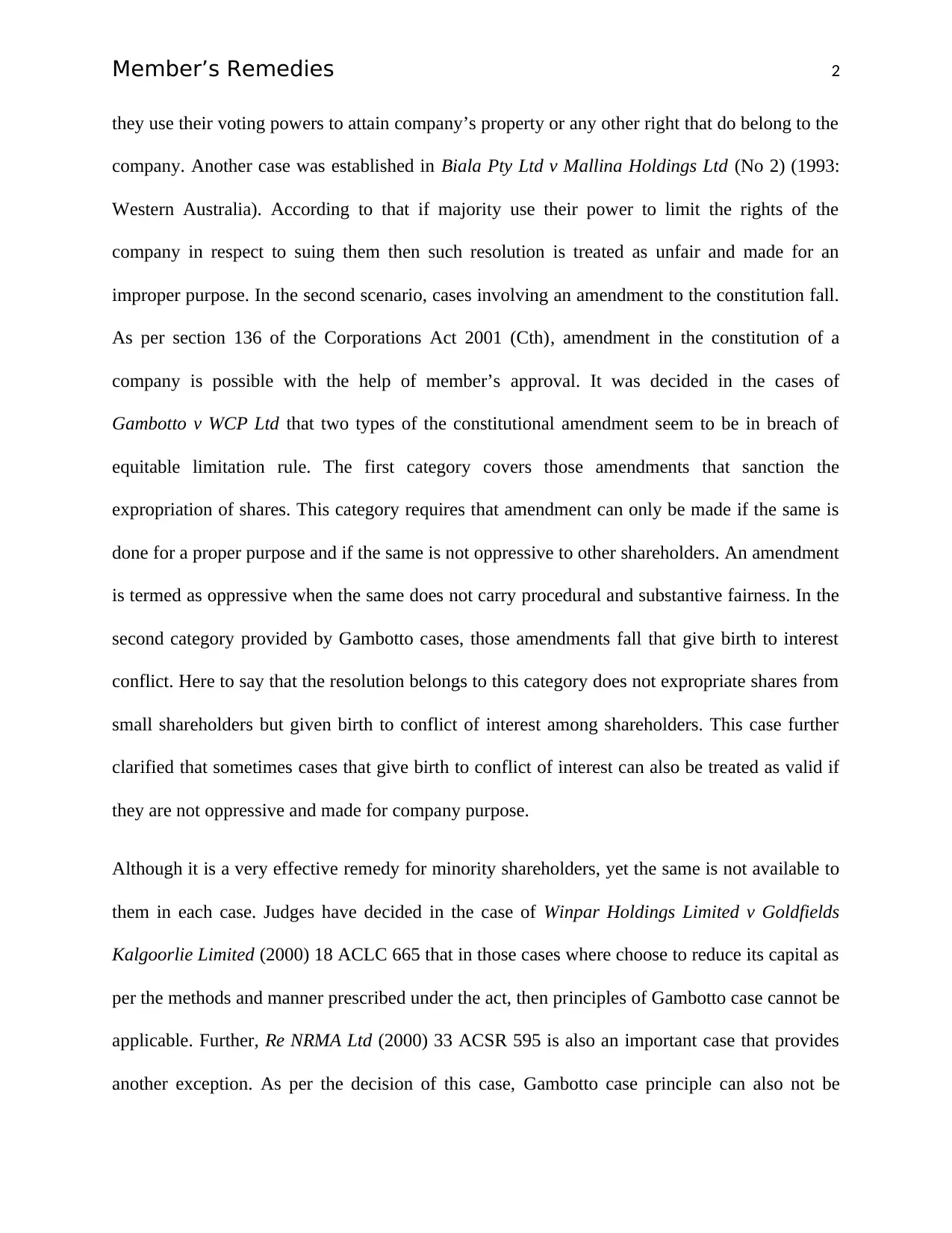
Member’s Remedies 2
they use their voting powers to attain company’s property or any other right that do belong to the
company. Another case was established in Biala Pty Ltd v Mallina Holdings Ltd (No 2) (1993:
Western Australia). According to that if majority use their power to limit the rights of the
company in respect to suing them then such resolution is treated as unfair and made for an
improper purpose. In the second scenario, cases involving an amendment to the constitution fall.
As per section 136 of the Corporations Act 2001 (Cth), amendment in the constitution of a
company is possible with the help of member’s approval. It was decided in the cases of
Gambotto v WCP Ltd that two types of the constitutional amendment seem to be in breach of
equitable limitation rule. The first category covers those amendments that sanction the
expropriation of shares. This category requires that amendment can only be made if the same is
done for a proper purpose and if the same is not oppressive to other shareholders. An amendment
is termed as oppressive when the same does not carry procedural and substantive fairness. In the
second category provided by Gambotto cases, those amendments fall that give birth to interest
conflict. Here to say that the resolution belongs to this category does not expropriate shares from
small shareholders but given birth to conflict of interest among shareholders. This case further
clarified that sometimes cases that give birth to conflict of interest can also be treated as valid if
they are not oppressive and made for company purpose.
Although it is a very effective remedy for minority shareholders, yet the same is not available to
them in each case. Judges have decided in the case of Winpar Holdings Limited v Goldfields
Kalgoorlie Limited (2000) 18 ACLC 665 that in those cases where choose to reduce its capital as
per the methods and manner prescribed under the act, then principles of Gambotto case cannot be
applicable. Further, Re NRMA Ltd (2000) 33 ACSR 595 is also an important case that provides
another exception. As per the decision of this case, Gambotto case principle can also not be
they use their voting powers to attain company’s property or any other right that do belong to the
company. Another case was established in Biala Pty Ltd v Mallina Holdings Ltd (No 2) (1993:
Western Australia). According to that if majority use their power to limit the rights of the
company in respect to suing them then such resolution is treated as unfair and made for an
improper purpose. In the second scenario, cases involving an amendment to the constitution fall.
As per section 136 of the Corporations Act 2001 (Cth), amendment in the constitution of a
company is possible with the help of member’s approval. It was decided in the cases of
Gambotto v WCP Ltd that two types of the constitutional amendment seem to be in breach of
equitable limitation rule. The first category covers those amendments that sanction the
expropriation of shares. This category requires that amendment can only be made if the same is
done for a proper purpose and if the same is not oppressive to other shareholders. An amendment
is termed as oppressive when the same does not carry procedural and substantive fairness. In the
second category provided by Gambotto cases, those amendments fall that give birth to interest
conflict. Here to say that the resolution belongs to this category does not expropriate shares from
small shareholders but given birth to conflict of interest among shareholders. This case further
clarified that sometimes cases that give birth to conflict of interest can also be treated as valid if
they are not oppressive and made for company purpose.
Although it is a very effective remedy for minority shareholders, yet the same is not available to
them in each case. Judges have decided in the case of Winpar Holdings Limited v Goldfields
Kalgoorlie Limited (2000) 18 ACLC 665 that in those cases where choose to reduce its capital as
per the methods and manner prescribed under the act, then principles of Gambotto case cannot be
applicable. Further, Re NRMA Ltd (2000) 33 ACSR 595 is also an important case that provides
another exception. As per the decision of this case, Gambotto case principle can also not be
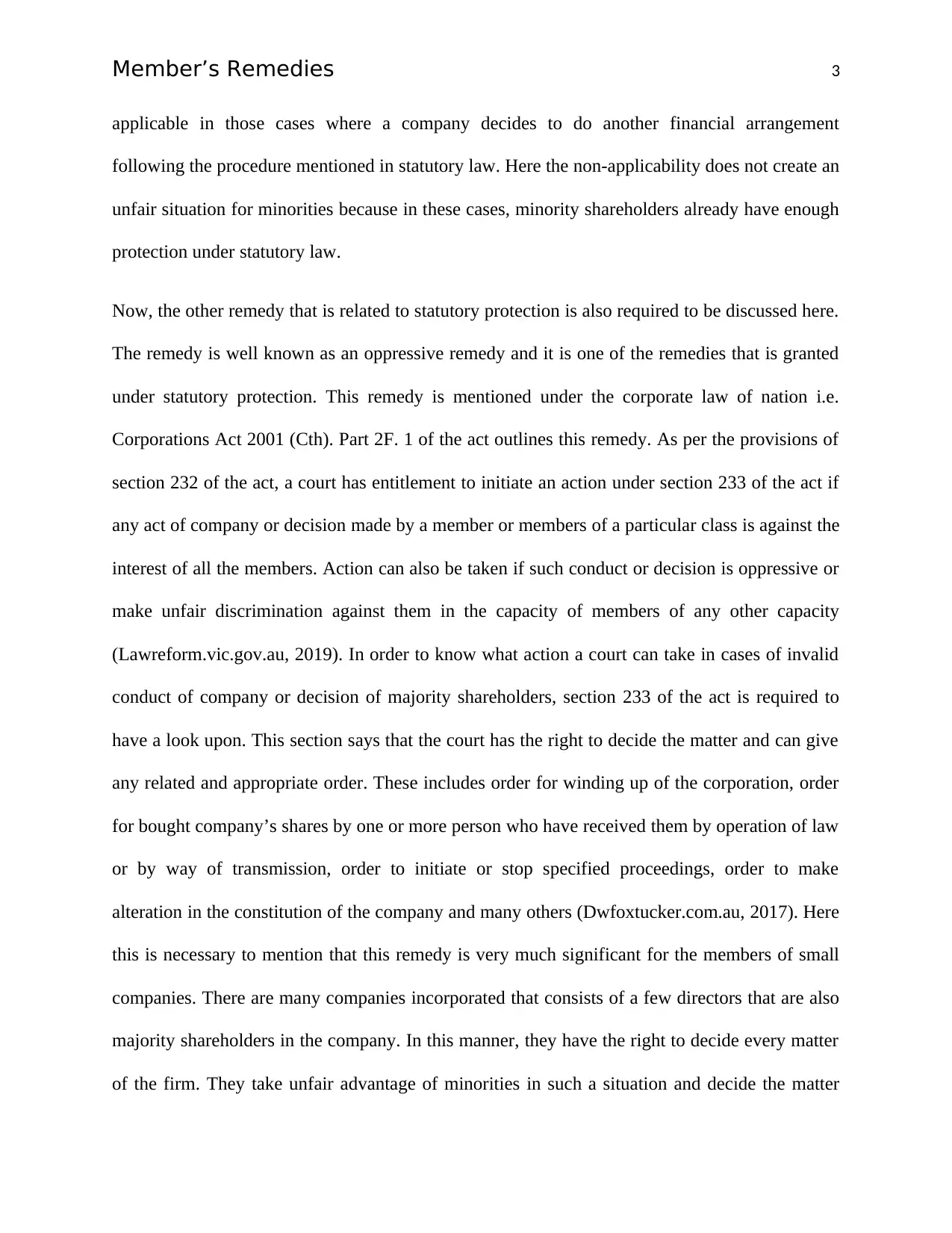
Member’s Remedies 3
applicable in those cases where a company decides to do another financial arrangement
following the procedure mentioned in statutory law. Here the non-applicability does not create an
unfair situation for minorities because in these cases, minority shareholders already have enough
protection under statutory law.
Now, the other remedy that is related to statutory protection is also required to be discussed here.
The remedy is well known as an oppressive remedy and it is one of the remedies that is granted
under statutory protection. This remedy is mentioned under the corporate law of nation i.e.
Corporations Act 2001 (Cth). Part 2F. 1 of the act outlines this remedy. As per the provisions of
section 232 of the act, a court has entitlement to initiate an action under section 233 of the act if
any act of company or decision made by a member or members of a particular class is against the
interest of all the members. Action can also be taken if such conduct or decision is oppressive or
make unfair discrimination against them in the capacity of members of any other capacity
(Lawreform.vic.gov.au, 2019). In order to know what action a court can take in cases of invalid
conduct of company or decision of majority shareholders, section 233 of the act is required to
have a look upon. This section says that the court has the right to decide the matter and can give
any related and appropriate order. These includes order for winding up of the corporation, order
for bought company’s shares by one or more person who have received them by operation of law
or by way of transmission, order to initiate or stop specified proceedings, order to make
alteration in the constitution of the company and many others (Dwfoxtucker.com.au, 2017). Here
this is necessary to mention that this remedy is very much significant for the members of small
companies. There are many companies incorporated that consists of a few directors that are also
majority shareholders in the company. In this manner, they have the right to decide every matter
of the firm. They take unfair advantage of minorities in such a situation and decide the matter
applicable in those cases where a company decides to do another financial arrangement
following the procedure mentioned in statutory law. Here the non-applicability does not create an
unfair situation for minorities because in these cases, minority shareholders already have enough
protection under statutory law.
Now, the other remedy that is related to statutory protection is also required to be discussed here.
The remedy is well known as an oppressive remedy and it is one of the remedies that is granted
under statutory protection. This remedy is mentioned under the corporate law of nation i.e.
Corporations Act 2001 (Cth). Part 2F. 1 of the act outlines this remedy. As per the provisions of
section 232 of the act, a court has entitlement to initiate an action under section 233 of the act if
any act of company or decision made by a member or members of a particular class is against the
interest of all the members. Action can also be taken if such conduct or decision is oppressive or
make unfair discrimination against them in the capacity of members of any other capacity
(Lawreform.vic.gov.au, 2019). In order to know what action a court can take in cases of invalid
conduct of company or decision of majority shareholders, section 233 of the act is required to
have a look upon. This section says that the court has the right to decide the matter and can give
any related and appropriate order. These includes order for winding up of the corporation, order
for bought company’s shares by one or more person who have received them by operation of law
or by way of transmission, order to initiate or stop specified proceedings, order to make
alteration in the constitution of the company and many others (Dwfoxtucker.com.au, 2017). Here
this is necessary to mention that this remedy is very much significant for the members of small
companies. There are many companies incorporated that consists of a few directors that are also
majority shareholders in the company. In this manner, they have the right to decide every matter
of the firm. They take unfair advantage of minorities in such a situation and decide the matter
Secure Best Marks with AI Grader
Need help grading? Try our AI Grader for instant feedback on your assignments.
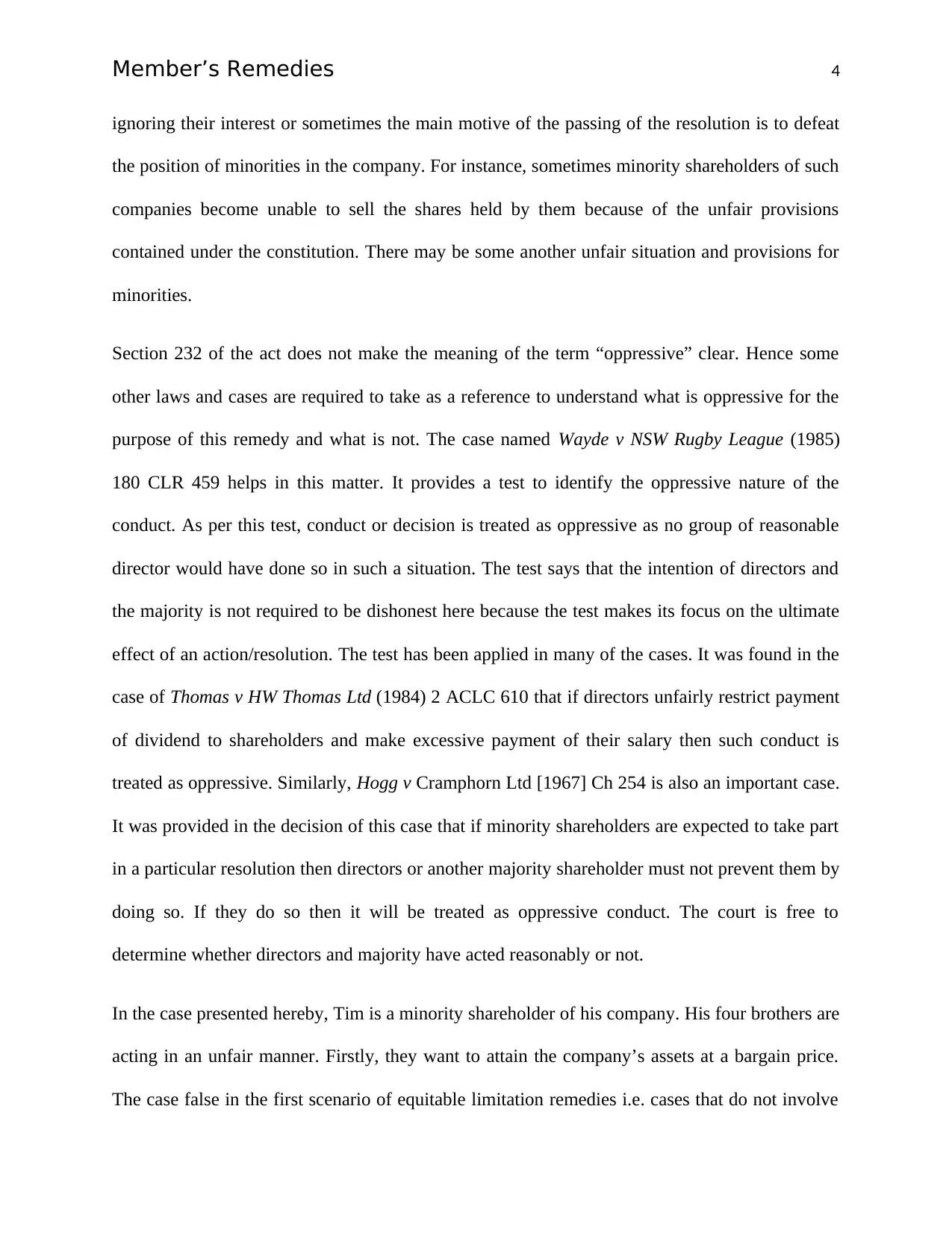
Member’s Remedies 4
ignoring their interest or sometimes the main motive of the passing of the resolution is to defeat
the position of minorities in the company. For instance, sometimes minority shareholders of such
companies become unable to sell the shares held by them because of the unfair provisions
contained under the constitution. There may be some another unfair situation and provisions for
minorities.
Section 232 of the act does not make the meaning of the term “oppressive” clear. Hence some
other laws and cases are required to take as a reference to understand what is oppressive for the
purpose of this remedy and what is not. The case named Wayde v NSW Rugby League (1985)
180 CLR 459 helps in this matter. It provides a test to identify the oppressive nature of the
conduct. As per this test, conduct or decision is treated as oppressive as no group of reasonable
director would have done so in such a situation. The test says that the intention of directors and
the majority is not required to be dishonest here because the test makes its focus on the ultimate
effect of an action/resolution. The test has been applied in many of the cases. It was found in the
case of Thomas v HW Thomas Ltd (1984) 2 ACLC 610 that if directors unfairly restrict payment
of dividend to shareholders and make excessive payment of their salary then such conduct is
treated as oppressive. Similarly, Hogg v Cramphorn Ltd [1967] Ch 254 is also an important case.
It was provided in the decision of this case that if minority shareholders are expected to take part
in a particular resolution then directors or another majority shareholder must not prevent them by
doing so. If they do so then it will be treated as oppressive conduct. The court is free to
determine whether directors and majority have acted reasonably or not.
In the case presented hereby, Tim is a minority shareholder of his company. His four brothers are
acting in an unfair manner. Firstly, they want to attain the company’s assets at a bargain price.
The case false in the first scenario of equitable limitation remedies i.e. cases that do not involve
ignoring their interest or sometimes the main motive of the passing of the resolution is to defeat
the position of minorities in the company. For instance, sometimes minority shareholders of such
companies become unable to sell the shares held by them because of the unfair provisions
contained under the constitution. There may be some another unfair situation and provisions for
minorities.
Section 232 of the act does not make the meaning of the term “oppressive” clear. Hence some
other laws and cases are required to take as a reference to understand what is oppressive for the
purpose of this remedy and what is not. The case named Wayde v NSW Rugby League (1985)
180 CLR 459 helps in this matter. It provides a test to identify the oppressive nature of the
conduct. As per this test, conduct or decision is treated as oppressive as no group of reasonable
director would have done so in such a situation. The test says that the intention of directors and
the majority is not required to be dishonest here because the test makes its focus on the ultimate
effect of an action/resolution. The test has been applied in many of the cases. It was found in the
case of Thomas v HW Thomas Ltd (1984) 2 ACLC 610 that if directors unfairly restrict payment
of dividend to shareholders and make excessive payment of their salary then such conduct is
treated as oppressive. Similarly, Hogg v Cramphorn Ltd [1967] Ch 254 is also an important case.
It was provided in the decision of this case that if minority shareholders are expected to take part
in a particular resolution then directors or another majority shareholder must not prevent them by
doing so. If they do so then it will be treated as oppressive conduct. The court is free to
determine whether directors and majority have acted reasonably or not.
In the case presented hereby, Tim is a minority shareholder of his company. His four brothers are
acting in an unfair manner. Firstly, they want to attain the company’s assets at a bargain price.
The case false in the first scenario of equitable limitation remedies i.e. cases that do not involve
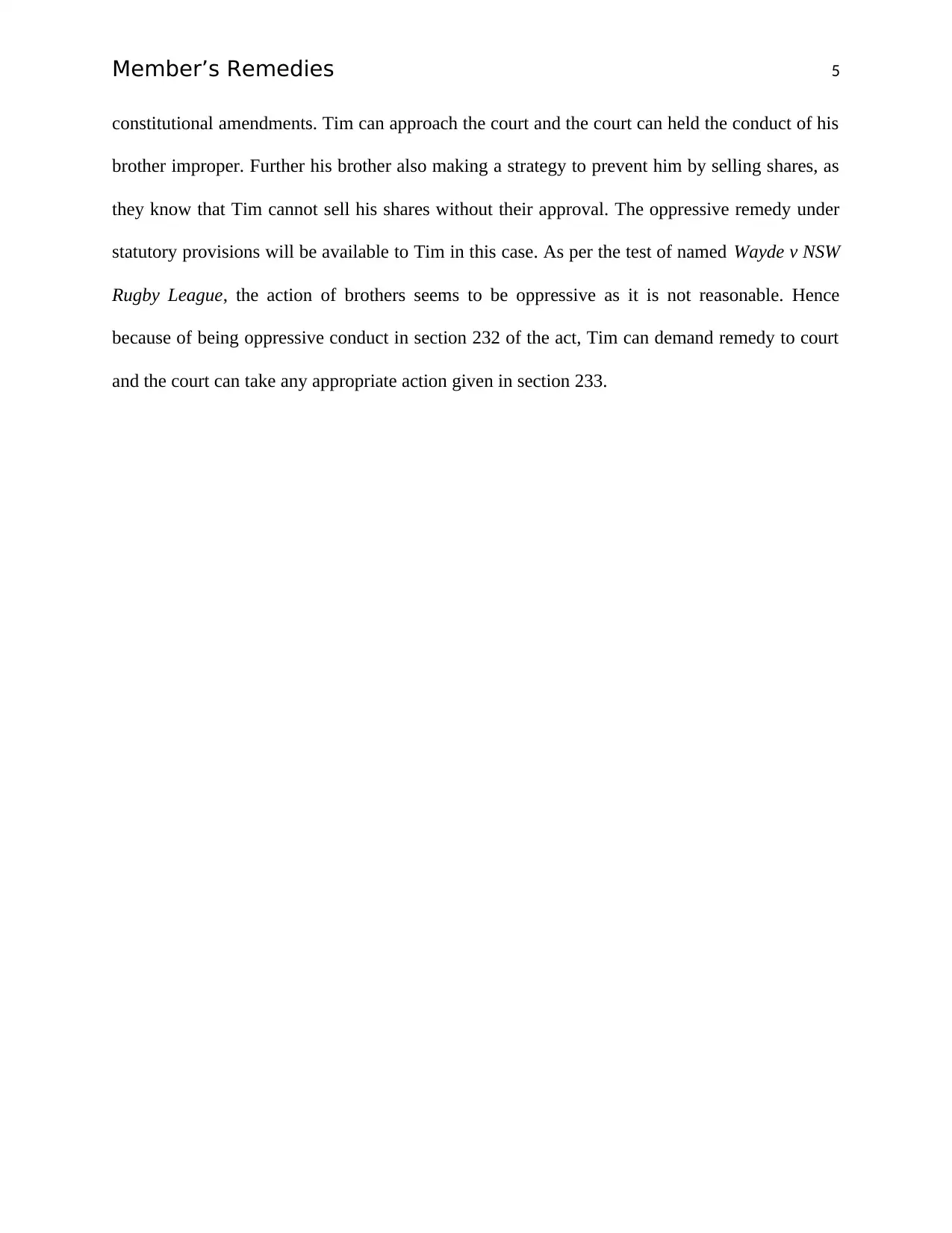
Member’s Remedies 5
constitutional amendments. Tim can approach the court and the court can held the conduct of his
brother improper. Further his brother also making a strategy to prevent him by selling shares, as
they know that Tim cannot sell his shares without their approval. The oppressive remedy under
statutory provisions will be available to Tim in this case. As per the test of named Wayde v NSW
Rugby League, the action of brothers seems to be oppressive as it is not reasonable. Hence
because of being oppressive conduct in section 232 of the act, Tim can demand remedy to court
and the court can take any appropriate action given in section 233.
constitutional amendments. Tim can approach the court and the court can held the conduct of his
brother improper. Further his brother also making a strategy to prevent him by selling shares, as
they know that Tim cannot sell his shares without their approval. The oppressive remedy under
statutory provisions will be available to Tim in this case. As per the test of named Wayde v NSW
Rugby League, the action of brothers seems to be oppressive as it is not reasonable. Hence
because of being oppressive conduct in section 232 of the act, Tim can demand remedy to court
and the court can take any appropriate action given in section 233.
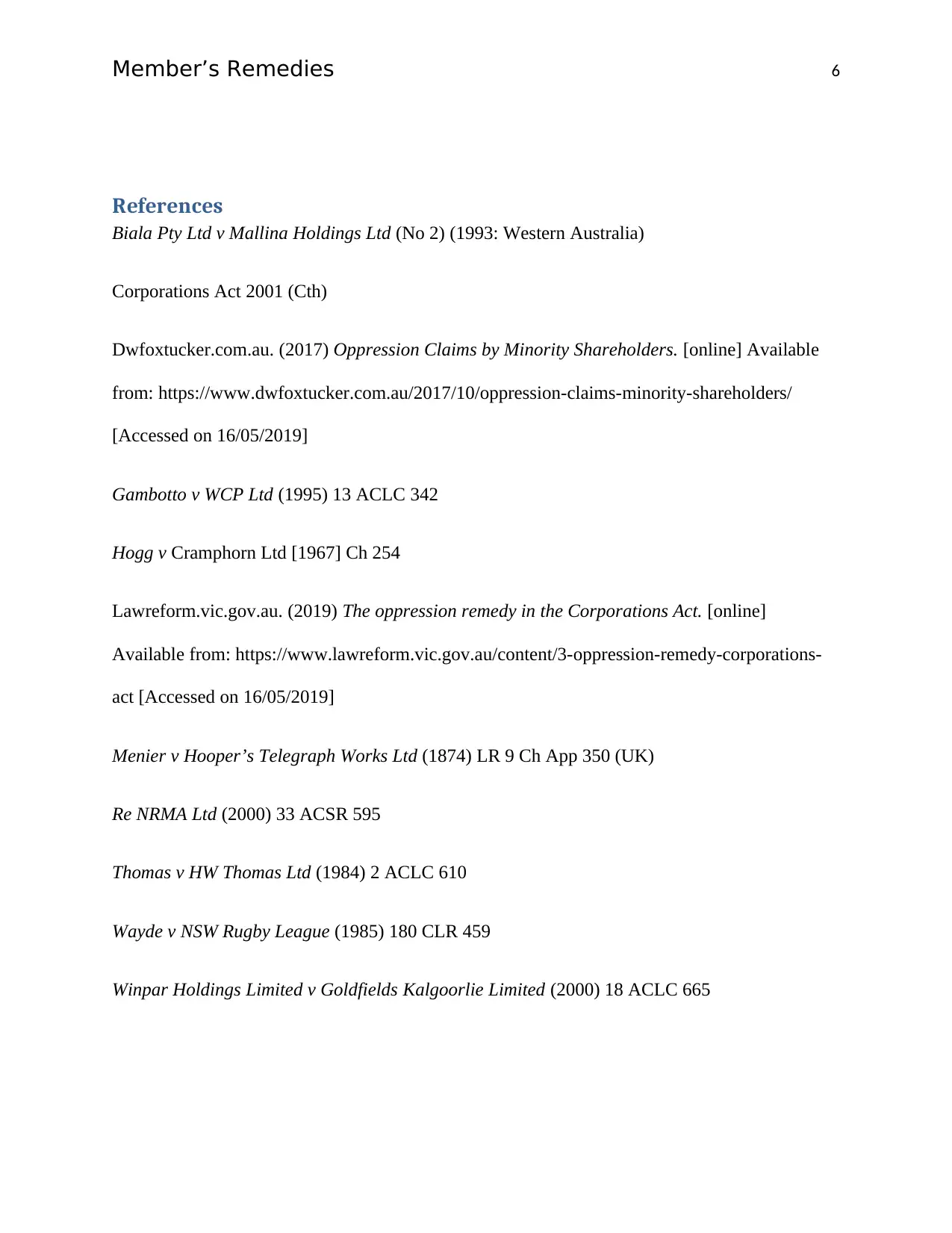
Member’s Remedies 6
References
Biala Pty Ltd v Mallina Holdings Ltd (No 2) (1993: Western Australia)
Corporations Act 2001 (Cth)
Dwfoxtucker.com.au. (2017) Oppression Claims by Minority Shareholders. [online] Available
from: https://www.dwfoxtucker.com.au/2017/10/oppression-claims-minority-shareholders/
[Accessed on 16/05/2019]
Gambotto v WCP Ltd (1995) 13 ACLC 342
Hogg v Cramphorn Ltd [1967] Ch 254
Lawreform.vic.gov.au. (2019) The oppression remedy in the Corporations Act. [online]
Available from: https://www.lawreform.vic.gov.au/content/3-oppression-remedy-corporations-
act [Accessed on 16/05/2019]
Menier v Hooper’s Telegraph Works Ltd (1874) LR 9 Ch App 350 (UK)
Re NRMA Ltd (2000) 33 ACSR 595
Thomas v HW Thomas Ltd (1984) 2 ACLC 610
Wayde v NSW Rugby League (1985) 180 CLR 459
Winpar Holdings Limited v Goldfields Kalgoorlie Limited (2000) 18 ACLC 665
References
Biala Pty Ltd v Mallina Holdings Ltd (No 2) (1993: Western Australia)
Corporations Act 2001 (Cth)
Dwfoxtucker.com.au. (2017) Oppression Claims by Minority Shareholders. [online] Available
from: https://www.dwfoxtucker.com.au/2017/10/oppression-claims-minority-shareholders/
[Accessed on 16/05/2019]
Gambotto v WCP Ltd (1995) 13 ACLC 342
Hogg v Cramphorn Ltd [1967] Ch 254
Lawreform.vic.gov.au. (2019) The oppression remedy in the Corporations Act. [online]
Available from: https://www.lawreform.vic.gov.au/content/3-oppression-remedy-corporations-
act [Accessed on 16/05/2019]
Menier v Hooper’s Telegraph Works Ltd (1874) LR 9 Ch App 350 (UK)
Re NRMA Ltd (2000) 33 ACSR 595
Thomas v HW Thomas Ltd (1984) 2 ACLC 610
Wayde v NSW Rugby League (1985) 180 CLR 459
Winpar Holdings Limited v Goldfields Kalgoorlie Limited (2000) 18 ACLC 665
1 out of 7
Related Documents
Your All-in-One AI-Powered Toolkit for Academic Success.
+13062052269
info@desklib.com
Available 24*7 on WhatsApp / Email
![[object Object]](/_next/static/media/star-bottom.7253800d.svg)
Unlock your academic potential
© 2024 | Zucol Services PVT LTD | All rights reserved.





